Windows 10, Windows 8.1 and Windows 8 come with Client Hyper-V so you can run a supported guest operating system inside a Virtual Machine. Hyper-V is Microsoft's native hypervisor for Windows. It was originally developed for Windows Server 2008 and then ported to Windows client OS. It has improved over time and is present in the latest Windows 10 release as well. Hyper-V allows exporting a virtual machine for backup. Also, you can use the import-export feature to move a virtual machine between your Hyper-V host machines.
Advertisеment
Note: Only Windows 10 Pro, Enterprise, and Education editions include the Hyper-V virtualization technology.
What is Hyper-V
Hyper-V is Microsoft's very own virtualization solution that allows creating virtual machines on x86-64 systems running Windows. Hyper-V was first released alongside Windows Server 2008, and has been available without additional charge since Windows Server 2012 and Windows 8. Windows 8 was the first Windows client operating system to include hardware virtualization support natively. With Windows 8.1, Hyper-V has got a number of enhancements such as Enhanced Session Mode, enabling high fidelity graphics for connections to VMs using the RDP protocol, and USB redirection which is enabled from the host to VMs. Windows 10 brings further enhancements to the native hypervisor offering, including:
- Hot add and remove for memory and network adapters.
- Windows PowerShell Direct – the ability to run commands inside a virtual machine from the host operating system.
- Linux secure boot - Ubuntu 14.04 and later, and SUSE Linux Enterprise Server 12 OS offerings running on generation 2 virtual machines are now able to boot with the secure boot option enabled.
- Hyper-V Manager Down-level management - Hyper-V manager can manage computers running Hyper-V on Windows Server 2012, Windows Server 2012 R2 and Windows 8.1.
Export a Virtual Machine in Hyper-V
An export gathers all required files into one unit - virtual hard disk files, virtual machine configuration files, and any checkpoint files. You can do this on a virtual machine that is in either a started or stopped state.
It is possible to export a Hyper-V virtual machine with either Hyper-V Manager, or PowerShell. Let's review both methods.
To export a Hyper-V Virtual Machine in Windows 10, do the following.
- Open the Hyper-V Manager from the Start menu. Tip: See How to navigate apps by alphabet in Windows 10 Start menu. It can be found under Windows Administrative Tools > Hyper - V manager.
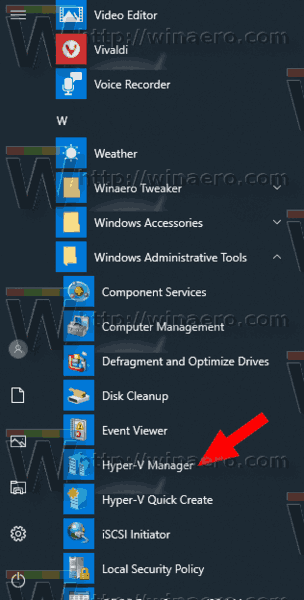
- Click on your host name on the left.
- In the list of your virtual machines, find the one you want to export.
- Right-click on it and select Export... from the context menu.
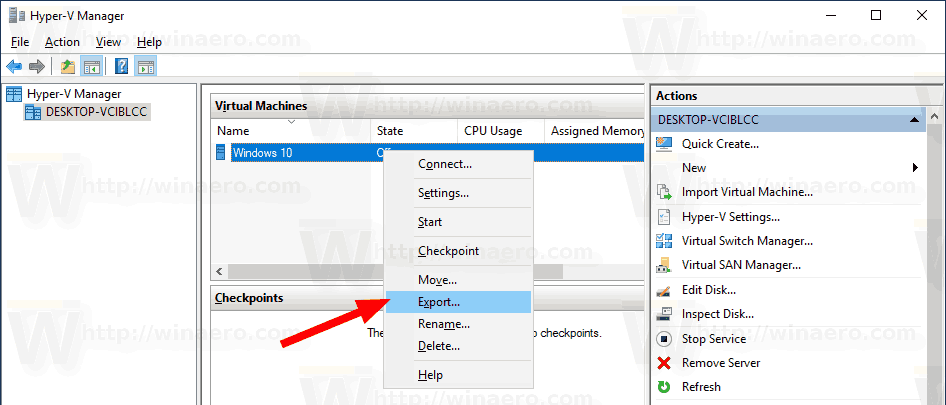
- Choose the folder where to store the exported files.
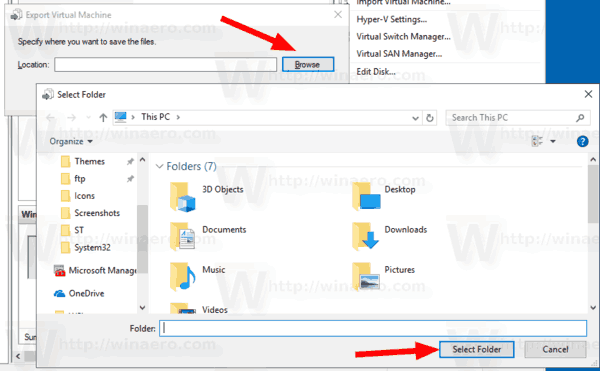
- Click on Export button.
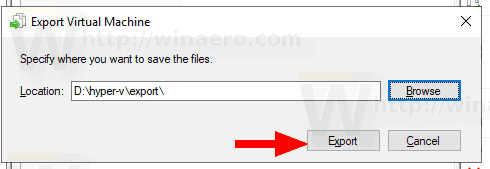
When the export is done, you can see all exported files under the selected location.
Alternatively, you can use PowerShell to export your virtual machines.
Export a Hyper-V VM with PowerShell
- Open PowerShell as Administrator.Tip: You can add "Open PowerShell As Administrator" context menu.
- Type or copy-paste the following command to get the list of available VMs:
get-vm

- Execute the next command:
Export-VM -Name 'Name of your VM' -Path 'Full path to the destination folder'
- Substitute the name of your VM with the the actual VM name you got in the step 3. Also, specify the correct path to the folder to store the exported files.
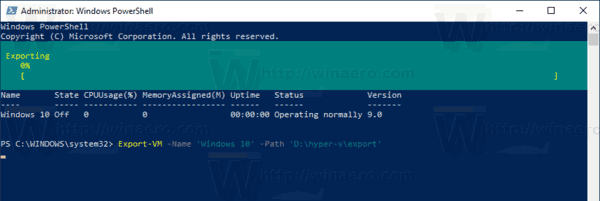
Your VM will now be exported. It may take some time to finish.

That's it.
Related articles:
- Change Hyper-V Virtual Machine Default Folder in Windows 10
- Change Hyper-V Virtual Hard Disks Folder in Windows 10
- Remove Floppy Disk Drive in Windows Hyper-V Virtual Machine
- Change DPI of Hyper-V Virtual Machine (Display Scaling Zoom Level)
- Create Shortcut for Hyper-V Virtual Machine in Windows 10
- Enable or Disable Hyper-V Enhanced Session in Windows 10
- How to Enable and Use Hyper-V in Windows 10
- Create Ubuntu Virtual Machines with Hyper-V Quick Create
Support us
Winaero greatly relies on your support. You can help the site keep bringing you interesting and useful content and software by using these options:
